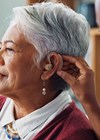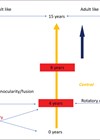A tailored approach combining counselling, sensory management and perceptual training can improve the effectiveness of hearing aids in managing tinnitus for individual patients.
Hearing aids are useful tinnitus therapy tools, according to tinnitus management guidelines. However, there are few published protocols as to how the best tinnitus results can be achieved using hearing aids. In this article, four auditory rehabilitation components that contribute to the hearing aid fitting optimisation for tinnitus management are considered (Figure 1) [1]. The recommendations are primarily based on 25 years of clinical research and practice from the Tinnitus Clinic of the University of Auckland, New Zealand.

Figure 1.
Counselling
Our consultations begin with non-judgemental reflective listening as to how the patient is feeling and reasons for attending the clinic. This is followed with a conversation about what the patient wants from therapy. This is an opportunity to assess if the patient would benefit from referrals to other professionals. The Client Oriented Scale of Improvement in Tinnitus (COSIT) is then used to identify individual goals and therapy priorities that may include hearing [2]. The individual and clinician consider the degree of tinnitus problem and the best means to meet each therapy goal. We provide psychoeducation focused on selective sound perception and attention. Tinnitus is discussed as a self-relevant but unexplained event. The counselling empowers patients to take a proactive role in explaining their tinnitus and executing behaviours to attain goals [3].
Instruction
Patients are instructed on methods that they can use to move towards achieving their goals. Instructions are provided to tinnitus patients on how to undertake relaxation, use positive imagery and improve sleep. If the patient is continually focusing on their tinnitus, perceptual training is recommended [4]. Reducing tinnitus impact on (with) hearing improvement is a frequent goal. Sensory management in the form of hearing aids is the technical solution to this. Patients are instructed on how to get the most benefit from amplification, including: need for consistent use during waking hours, selecting programs to adjust for changing environments and, when appropriate, use of additional sound stimulation.
Sensory management
When improved hearing is a COSIT goal, hearing aids are usually recommended. If the individual does not have hearing communication issues, we will provide sound stimulation through headphones. Amplified sound through hearing aids may partially mask and result in less attention to tinnitus. Improving communication should improve wellbeing, resulting in less negativity towards tinnitus. Our tinnitus hearing aid fittings are almost always bilateral and focus on achieving normal auditory balance between ears. When possible, we select open fitting hearing aids to avoid occlusion. We programme aids according to the Desired Sensation Level prescription and validate using real ear measures. The effective amplification response can be determined by comparing low-level amplified sound to the audiogram using these real-ear measures [5]. Flexibility in adjusting frequency response and compression are desirable hearing aid characteristics.
To ensure audibility of low-intensity sounds in quiet settings, low compression knee points should be chosen. Noise reduction and expansion are usually turned down, or off, when possible. This enables quiet background sounds, which might be considered to be annoying for non-tinnitus sufferers, to be audible for partial masking of the tinnitus. Likewise an omnidirectional microphone setting is desirable in quiet environments to enable audibility of sounds coming from behind the user. The role of the manual adjustments described above will need to be reconsidered with the increasing application of artificial intelligence (AI) to hearing aids. It is possible that in the short-term, AI focused on speech extraction from noise may not benefit tinnitus sufferers. AI algorithms for speech may reduce masking. This potential downside of AI may be overcome by enabling the user to play sounds onboard the aids or via streaming. Eventually tinnitus-specific algorithms may emerge, enabling automatic tinnitus optimisation.
The ability to achieve partial masking is related to the degree of hearing loss. Patients with worse than a mild low-frequency hearing loss may not be able to hear amplified low-frequency sounds sufficiently for any masking and are less likely to benefit from hearing aids alone. Hearing aid bandwidth is also important; if tinnitus pitch is higher than the high-frequency range of the aids, overlapping of amplified sound and tinnitus will not occur. Reducing similarity in frequency of sound and tinnitus pitch reduces masking. If patients have greater than a mild low-frequency hearing loss, or tinnitus is outside the effective amplification range of the aids, we recommend adding additional sounds via streaming or available in the hearing aid software.
Perceptual training
Reduced focus on tinnitus is a frequent COSIT therapy goal. Perceptual training is an active process involving listening and then responding with feedback and reward for improved performance. Attention-based training methods aim to improve ability to listen for real-world sounds, while selectively inhibiting tinnitus. Perceptual training is usually undertaken daily for a short time (10–30 mins). This training may help patients who are struggling to adapt to tinnitus despite hearing aid use or are not suited to, or unwilling to wear, hearing aids. The training sounds can be streamed to hearing aids or be used with earphones [4].
Concluding perspective
Hearing aids appropriately selected and programmed can be effective tinnitus management tools. A ‘one size fits all’ approach to tinnitus is unlikely to be successful. Therapies need to be personalised for patients’ specific needs and priority should be given to attaining those goals. Sensory management in the form of hearing aids is but one part of a comprehensive auditory rehabilitation process that should also include counselling, instruction and perceptual training.
References
1. Boothroyd A. Adult aural rehabilitation: what is it and does it work? Trends Amplif 2007;11(2):63–71.
2. Searchfield GD. A client oriented scale of improvement in tinnitus for therapy goal planning and assessing outcomes. J American Acad Audiol 2019;30(4):327–37.
3. Searchfield GD, Schecklmann M, Kleinstaeuber M. Tinnitus Counselling and Psychoeducation. In: Schlee W, Langguth B, De Ridder D, et al (Eds.). Textbook of Tinnitus. Springer Cham; 2024:529–44.
4. Searchfield GD, Sanders PJ. A randomized single-blind controlled trial of a prototype digital polytherapeutic for tinnitus. Front Neurol 2022;13:958730.
5. Searchfield GD. Hearing Aids and Tinnitus. In: Tyler R (Ed.). Tinnitus Treatment. New York, USA; Thieme; 2006:161–75.
Declaration of competing interests: GDS is founder of, and has financial interests in, TrueSilence Therapeutics Inc a tinnitus therapy company. He has undertaken research funded by hearing aid manufacturers.










